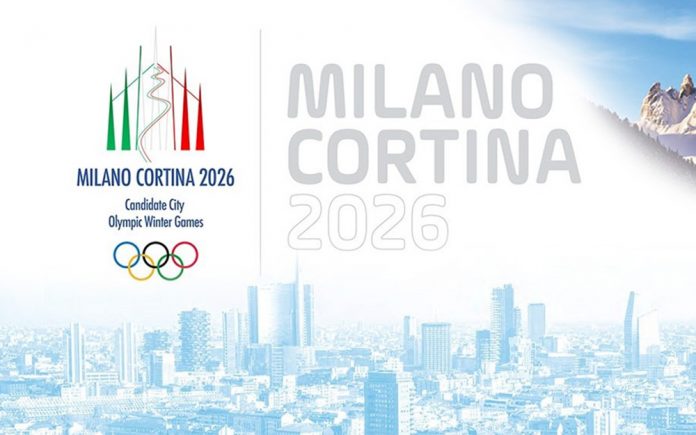
By Rick Riozza
For some reason—during all the pandemic stuff, I simply was not aware that the next winter Olympics in 2026 will be held in Milano/Cortina. It wasn’t until I turned on the final ceremonies of the Beijing games and observed the torch being handed over to the Italian contingent and the announcement that the games would be played in & around the Italian Alps—fantastico!! Open a bottle of Italian wine! Let’s toast & celebrate!—Saluti!!
How fortunate it is for us wine enthusiasts, to be real time participants, enjoying so many wine venue cities: the Summer Olympics in Paris 2024—the Champagne region just 30 minutes away by train; the summer games in Los Angeles 2028—Santa Barbara wine country just two hours by car; and coming up for the next winter games, Milano/Cortina with its sprawling wine region of Lombardia, where the great Franciacorta wine is produced.
So hey—it looks like we have only four years to get ourselves ready to fully understand the wines of the Lombard region. For when you arrive there, this column assures that you’ll make friends quickly as you’ll be able to order any of the wonderful wines available locally and know exactly what you’re saying and expecting! In Italian that’s called “sprezzatura”. Ciao! Bella!—you’re too cool!
It’s an exciting time for all of you Italophiles, so let’s get started. We know about the Tuscany, Piemonte, and Veneto regions of Italy. And we’ve heard of Calabria, Sicily, and Campania—but perhaps not as much on Lombardy.
Lombardia has always been the center of big business in Italy, be it silk and textile manufacturing in the Lake Como area (okay—I know, you already know, that your heartthrob George Clooney has his 18th Century villa on the lake). But there is also mining and metallurgy in Brescia, and of course you’ve heard of the big banking and fashion center there in Milano. Milano is the hub of Lombardia.
But Lombardia’s richness is not merely financial. The Padana plain spreads across the region, fed not only by the Po River but by the tangle of tributaries, which flow down from the Alpine lakes. The lowlands of the Padana produce a wealth of rice for risotto and offer one of the largest stretches of pasture in Italy.
Indeed, few other Italian regions can rival Lombardia’s assortment of cheese, most of which are from cow’s milk: There’s the salty, nutty Grand Padano—the more widely produced sibling of Parmiginano-Reggiamo, that we’ll tend to purchase at the local Trader Joe’s. How about the pungent veiny Gorgonzola, named for the small town east of Milano; the soft funky Robiola; and the sharp runny Alpine specialty, Taleggio.
(There’s no way I’m going to get through writing this article without rummaging through the fridge and grabbing some cheese, munching on some salami, pulling on some bread and pouring some wine—buon appetito!)
So with all of that in mind, and despite being Italy’s biggest and most populous region, Lombardia is not a prodigious wine producer. But stylistically speaking, this region has everything: serious Franciacorta sparklers, that most agree are the best in Italy; crisp, aromatic still whites from Lake Garda—which at a minimum stand up to the best Soave; powerful, aromatic Nebbiolo reds that can rival Barolo in depth and complexity; and a new generation of plump Bonarda, and fragrant Pinot Neros (Pinot Noir).
I know this may be a lot to take in for a casual desert wine column—and perhaps I’ve poured a bit too much wine, but as you’ll see what I’m saying: there’s a lot vino to learn and love in this region just south of the Italian Alps. And believe me, we’re going to have fun covering all of the stuff through in and throughout the wine column in the up-coming months.
We’ve mentioned the Franciacorta sparkling wine already—and it deserves mentioning all the time. As we’ll get into it along the line, it is the Italian Champagne.
Sadly to note: Franco Ziliani, the winemaker and revered “founding father” of Franciacorta, recently died—of natural causes, over the past holidays at his home on the shores of the appellation’s Lake Iseo. He lived a long life and enjoyed much. His passing came at a historic milestone, 60 years after making his first groundbreaking vintage of sparkling for Berlucchi, he came to own the winery through his partnership with Count Guido Berlucchi.
In Senore Ziliani’s honor, let’s review a popular and ever available Berlucchi bubbly: Berlucchi NV Cuvée Imperiale Brut Franciacorta ($35) Easy and nice light aromas of melon, white peach and almond skin. This polished sparkler shows green apple, pear, citrus, brioche, toast, and almonds that delivers nice acidity and long persistence of fine bubbles.
As one would expect, prices for the Franciacorta sparkler can zoom ahead depending on the winemaker’s craft & vintage. For instance, the 2011 Ca’ del Bosco Annamaria Clementi Rosé Franciacorta DOCG goes for around $160. A definite treat for the price as the wine compares well with four-hundred-dollar French rosé on the market.
As we continue to cover the wines produced around Milano in our future columns, we’ll be certain to present both reasonably priced wine and those for celebrations. Onward to Milano!! Saluti!










































